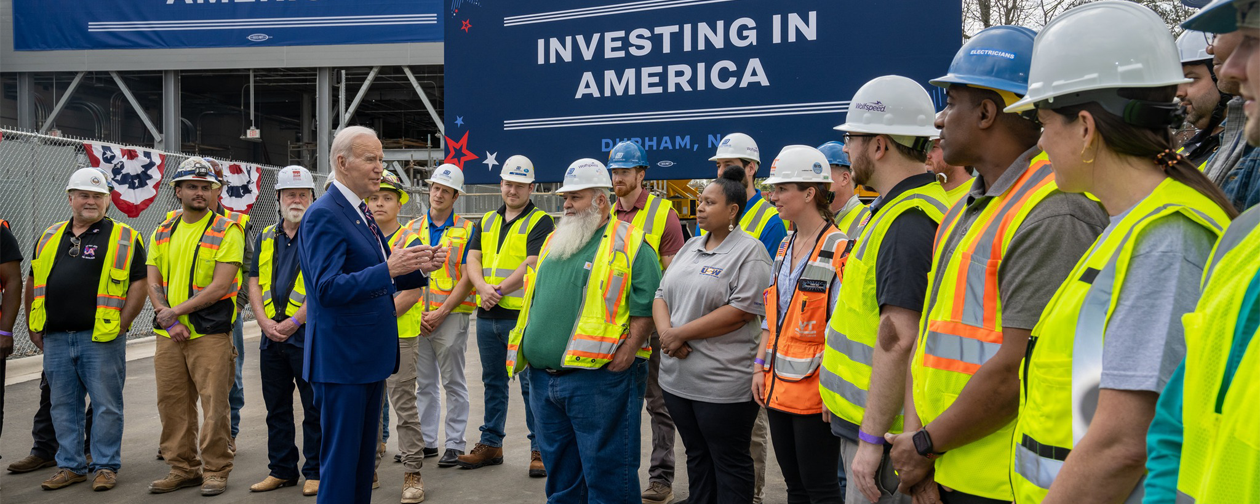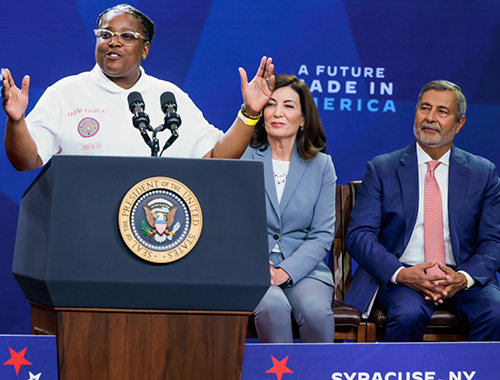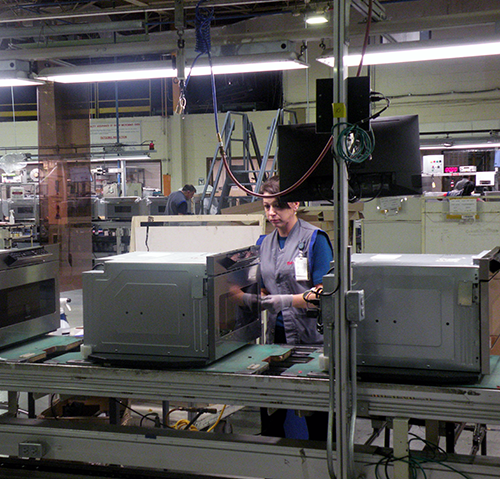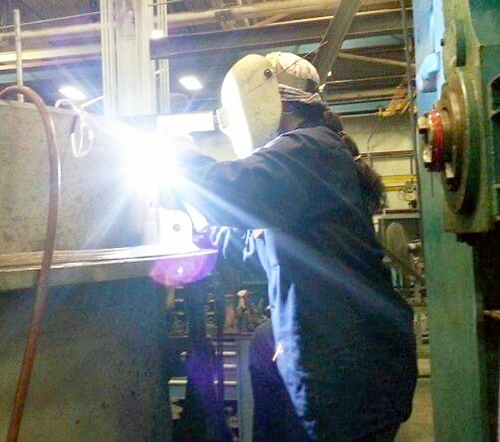America’s factory floors are busier than they’ve been in generations. Massive new plants are under construction. And more are on the way as manufacturers pour more than $500 billion into U.S. microchip production and clean energy technology.
It is nothing short of a modern industrial revolution.
“After decades of corporate offshoring and devastating job losses, we’re talking about half a trillion dollars — so far — in new investments in American industry,” said International President Kenneth W. Cooper.
“For workers and the IBEW, there is nothing but opportunity right now.”
Nearly 20 million workers were employed in manufacturing when the sector last peaked in 1979. The IBEW’s Manufacturing Branch boasted nearly 400,000 members. Those numbers fell to a low of 30,000 over the next 40 years.
The national slide continued until the pandemic, when factory jobs ticked up slightly to produce vaccines and supplies needed to fight COVID-19.
 |
| President Joe Biden speaks with workers building a silicon carbide plant in North Carolina. More than 800,000 jobs — thousands of which going to IBEW members — have been added to the manufacturing sector on Biden’s watch. |
Then President Joe Biden hit the accelerator, declaring that “Made in America” is back for good.
“One of the many reasons the IBEW backed Joe Biden so early in his campaign was his promise to make the U.S. a world leader in manufacturing once again,” Cooper said. “And he’s doing exactly that.”
Biden’s historic job-creating legislation and multipronged agenda for a robust American supply chain have added 800,000 new jobs to domestic production lines over the past 2½ years. And the demand for workers keeps rising.
“We’re in the middle of a revolution that will make the U.S. a global manufacturing center once again,” Cooper said. “But this revolution didn’t just happen. The IBEW was on the front lines of making it possible.”
 |
| Journeywoman Shawni Davis of Syracuse, N.Y., Local 43 speaks at an event hailing Micron’s plans for a massive microchip manufacturing complex. “This means good-paying union jobs,” she said in warming up the podium for Biden. |
Commitments to build and expand high-tech factories began early in the Biden administration. But they have skyrocketed since the president and lawmakers — lobbied intensely by IBEW leaders and activists — pushed game-changing bills through Congress: the $1.2 trillion Bipartisan Infrastructure Law in November 2021, followed in August 2022 by the $550 billion Inflation Reduction Act and the $53 billion CHIPS and Science Act.
“Our manufacturing sector has the ability to grow like never before as we organize and train members for the jobs of the future,” Cooper said. “And that’s on top of the tens of thousands of IBEW jobs building those new plants and the infrastructure that supports them. If you trust us to build your factory, you ought to trust us to work in it, too.”
In fact, construction spending related to manufacturing in the U.S. nearly tripled in just two years, from a $76 billion annual rate in May 2021 to $195 billion in May 2023, according to Federal Reserve data.
Biden hailed the surge in manufacturing in a series of major speeches this summer — several of them with familiar shout-outs of respect and affection for the IBEW. One took place in late July at an Auburn, Maine, textile plant, where the president signed an executive order called “Invent it Here, and Make it Here.”
“Here’s how it works,” Biden said. “Federal agencies research and fund development to encourage innovation. This executive order dictates that those agencies have to prioritize domestic manufacturing when it comes time to bring those inventions to market. They can’t go abroad. They have to look here, (at) who can do it here. That’s the law.”
Investments Skyrocket
The billions available in federal funds are igniting private investments: In 2022, the amount of money that companies committed to high-tech manufacturing in the United States was 20 times higher than the value of projects announced in 2019, according to reporting by The Financial Times.
 |
| A member of Milwaukee Local 494 works on an oven manufacturing line at Sharp. The Financial Times reported that, in 2022, the amount of money that companies committed to high-tech manufacturing in the U.S. was 20 times higher than the value of projects announced in 2019. |
In June, a Bank of America Private Bank report called the boom the “early stages of a manufacturing supercycle,” and in July, Morgan Stanley published a rosy revision of its earlier economic forecasts.
“The economy in the first half of the year is growing much stronger than we had anticipated,” the company’s chief U.S. economist wrote, citing manufacturing construction as a key factor. “The narrative behind the numbers tells the story of industrial strength in the U.S.”
Currently, IBEW employer Intel is building four new semiconductor plants, two in Arizona and two in Ohio, and is in the permitting process to spend billions more expanding its facilities in Oregon. Micron Technology is at work on a $100 billion complex of chip factories in central New York, and featured a Syracuse Local 43 member at a news conference last October to announce its plans. This was featured in the January issue of The Electrical Worker.
Another major area of growth for the IBEW is in the production of batteries and parts for a nationwide network of electric vehicle charging stations.
“Companies that weren’t in EV manufacturing are now getting into it to meet demand,” said Manufacturing Director Brian Lamm, pointing to Siemens and Ingeteam as examples.
In Milwaukee, wind turbine maker and Local 2150 employer Ingeteam is expanding its already massive factory to build 500,000 electrical vehicle chargers over the next five years.
The project is a case study in the value of the IBEW’s working relationship with the Biden administration: In May, Local 2150 Business Manager Jim Meyer was able to help Ingeteam connect with the White House Made in America Office to find the domestic components it will need to assemble the chargers, opening the door to new IBEW jobs.
 |
| At a Sharp manufacturing facility, a Milwaukee Local 494 member does some welding. As manufacturing booms, so do organizing prospects, and business managers nationwide need to be ready to capitalize on them — even in so-called right-to-work states, where it might be harder to organize, but it’s not impossible. |
Siemens, which employs hundreds of IBEW members in Texas and California, is investing $54 million to build a new facility and add a production line to another as it expands to produce EV components. A major data center is also in the works.
“Our members build and ship switches and breakers all over the country,” Arlington, Texas, Local 220 Business Manager Josh Worthey said, noting that hundreds of new jobs are being created as the company grows — secure, solidly middle-class jobs, starting at hourly rates well above the national average for an electrical assembly position.
Organize, Organize, Organize
As manufacturing booms, so do organizing prospects, and Lamm said business managers nationwide need to be ready to capitalize on them.
“Our gains are spread out across the country, including the ‘industrial belt’ that’s been so ravaged by outsourcing,” he said. “EV car charging, renewable energy, semiconductors, battery storage — they all demand the unique skills of IBEW members.”
In so-called right-to-work states, where the law lets freeloading workers reap the benefits of union representation without paying dues, “it might take more time to organize,” Lamm said. “But we never say it’s impossible. We just have to get out there and start taking advantage of all the opportunities out there now.”
Right-to-work Texas is a prime example. “Organizing is a challenge. You have to stay on top of it all day, every day,” Worthey said. “Fortunately, we have a really great relationship with Siemens, advisory board and our counterparts at IG Metals.”
As the company navigates an influx of new workers and new work, he said, both sides are learning. “Our stewards’ skills are getting stronger by the day.”
The federal spending bills include unprecedented labor standards for construction and tax incentives for builders to comply, all part of Biden’s agenda for stronger unions and better wages, benefits and job conditions for America’s workers.
But there’s a steeper hill to climb once the factory is built.
“There’s a recognition by the administration that the laws don’t include the same kinds of labor standards and organizing incentives for manufacturing workers as they do for members of the construction and utility trades,” said Erica Fein, an IBEW government affairs specialist.
But Biden staffers are working with unions to find solutions. “There is a willingness to engage with us,” she said. “We talk regularly with them about making it easier to unionize the country’s manufacturing workforce.”
The administration, like the IBEW, also is keenly interested in manufacturing-sector apprenticeships.
“Federal agencies want unions like the IBEW to apply for new training dollars,” Fein said. “The Department of Labor’s infrastructure pathways grant that encourages establishing or expanding apprenticeships in key industries is just one example.”
For Cooper, organizing has been job No. 1 since he took office in January, and he stresses to business managers and local organizers that the Brotherhood is behind them 100%. “Whatever support you need from the I.O. or your district’s vice president, you’ve got it,” he said.
The Membership Development Department is at the ready.
“We are encouraging all locals to work with us on strategic organizing plans,” said Jennifer Gray, director of the department’s professional and industrial organizing arm that specializes in the manufacturing sector.
Staffers have been mapping out organizing opportunities across the country, Gray said, with an eye on such data points as new or existing prospects, the industry involved, the status of construction projects and the number of potential members.
The data is stored in the web-based Action Builder system, the union’s robust and customizable tool to streamline the work of organizing teams. Those kinds of digital resources are vital today, but successful campaigns still depend on getting the word out about the many advantages of joining the IBEW.
Toward that end, Gray said public information campaigns and orientations for new employees are as indispensable as ever. “The most important organizing tool we have is our members talking about how the IBEW changed their life,” she said.
Cooper doesn’t want a single opportunity for the IBEW in manufacturing to fall through the cracks.
“It means looking at all the manufacturing projects coming down the road and making a plan to bring those folks into the IBEW,” he said. “In every corner of the nation, ground is breaking and factories are going up. We must use every connection we have to get our foot in the door.”